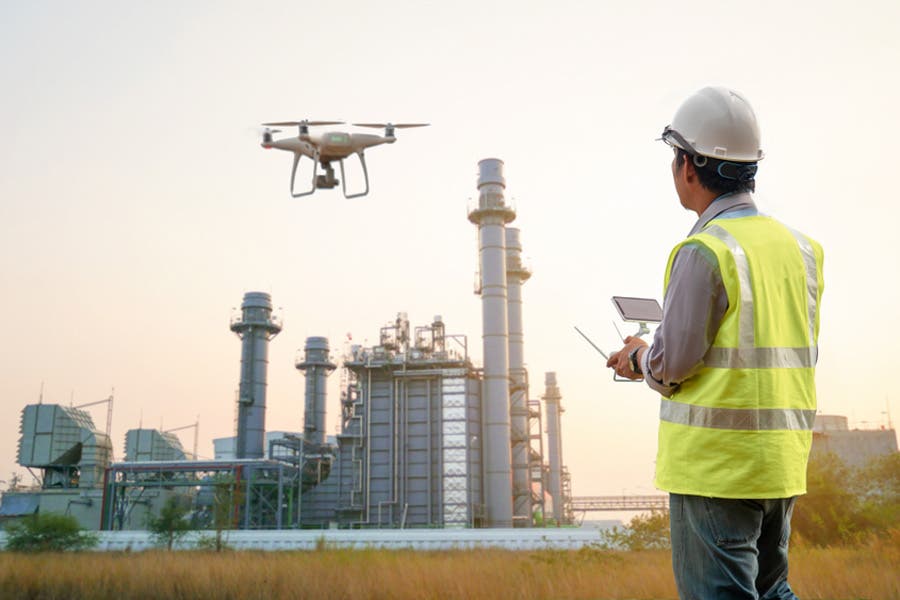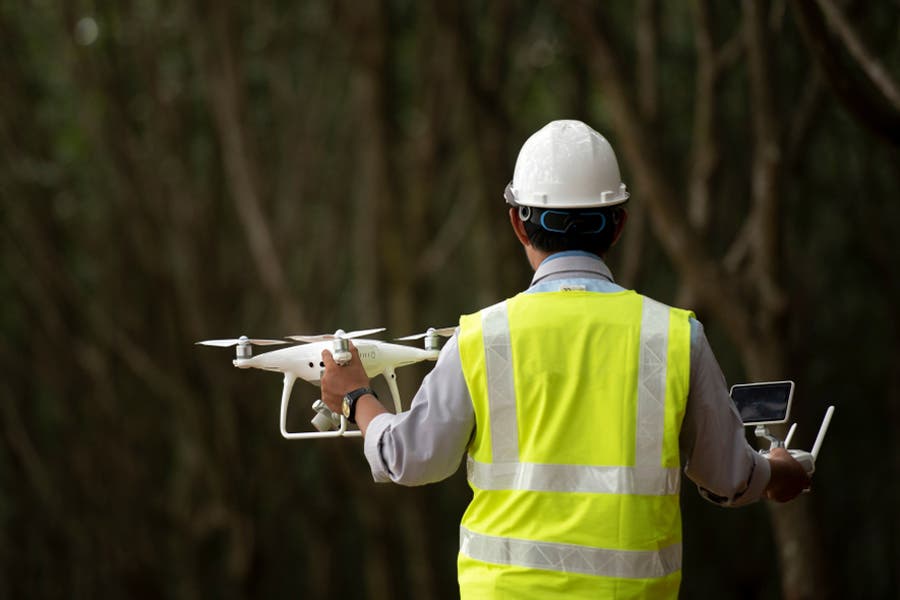Today’s consumer drones are no longer just for media production and recreational use. In fact, numerous drones are being used for professional applications (aside from filmmaking and real estate marketing) with the use of mounted thermal cameras. But before we delve into the many uses of drone thermal cameras, let’s talk about what thermal cameras are and what makes them important today.
What is a Thermal Camera?
What we see on thermal cameras are blue to red smears, with each shade of color representing varying temperatures emitted by humans, objects, and materials. Blue typically indicates colder zones while red represents hot zones. However, some thermal cameras use other color schemes.Depending on the user and application, the cameras’ thermal scale can be limited and adjusted to lower or increase the color contrast for more precise temperature analyses.
Thermal cameras have been around for several decades, with the first ones being part of military equipment that was used to see and target enemies at night or across smokey battlefields. Today, thermal cameras are developed into handheld and mountable devices to provide thermal imaging solutions for a variety of demanding industrial, enterprise, security, and military applications.
Thermal Drone Cameras

There are obviously limitations to using handheld thermal cameras, as with mounting them high up on buildings for monitoring purposes. Following the modernization of drone technology and the development of more compact consumer drones, integrating thermal cameras seemed to be the obvious next step to increase the efficiency of thermal imaging.
In 2015, DJI and FLIR Systems combined their industry-leading aerial platforms and first-class infrared imaging technologies to develop one of the first drone with thermal camera (aka thermal imaging drone camera), the DJI Zenmuse XT. Thermal cameras rolling out to the wider drone market has expanded the use of prosumer drones and brought thermal imaging to new heights — both literally and figuratively.
Since then, FLIR has continued to produce other variants of thermal cameras to meet the specific demands of different industries. Other drone companies — like Parrot, Yuneec, and Autel Robotics — have also made it possible for local government bodies, private companies, farmers, and even regular homeowners to utilize thermal imaging to improve their business, surveillance, maintenance, and safety efforts.
Common Uses for Thermal Drone Cameras

We already know that drone thermal cameras can be used in a variety of ways, more so with its wider market reach. Let’s find out its most popular uses as we divide them by category below.
Roof and Building Inspections
As you can imagine, drone thermal imaging is incredibly efficient in inspecting residential and commercial exteriors in the construction industry. It’s great for scanning leaks and finding sources of energy inefficiencies and exterior issues. For homes, this can save you a lot of money in heating and bigger repair costs that can result from delayed detection of water and structural damage.
Drones also shorten inspections of large roof decks to just a few minutes, especially if the drone will fly high enough (under the legal limit) to get a view of the entire roof or building and fly lower if there are problem areas that need more detailed imagery.
Solar Field Inspections
Like commercial roof inspections, solar field inspections can take a lot of time if they were to be inspected manually by foot. Drones can evaluate a large solar area in a fraction of the time and cost from high up in the air, as well as use its high sensitivity features to track cell defects and obtain accurate readings of other specific problem areas on a more regular basis.
Electrical Inspections
With thermal cameras and certified drone operators, electrical facilities — including substations, power lines, and power distribution systems — can be monitored and examined for overheating spots, damaged components, and faulty connections from a safe distance without the need for expensive equipment or putting lives at risk.
Drones save a lot of time and cost by limiting the number of engineers to just a few drone pilots and flight controllers with built-in or remote displays to carry out the operation — even in hard to reach areas.
Oil and Gas
Under the oil and gas category are two specific areas of application: refinery and pipeline inspection. For refinery inspections, thermal imaging drones are equipped with optical gas imaging (OGI) sensors and can conveniently quantify leaks from a safe distance. Pipeline inspections, on the other hand, use fixed-wing drones with greater operational performance.
Both applications cost significantly less compared to the traditional use of manned aircraft. Aside from capturing high-resolution images, many thermal imaging drones can also stitch multiple images into an orthomosaic map to provide both a broad overview and more detailed information that reveal problem spots as well as the life cycle of specific components for analysis.

Agriculture
There’s an increasing number of drones used in agriculture, as it proves to be very efficient in providing precise temperature measurements to quantify crop diseases, insects, salinity, and other external factors that can decrease yield. Ranchers also utilize thermal drones to keep track of their herds and find those who may have wandered off to remote areas.
Road and Bridge Inspections
Thermal cameras are especially useful in determining the degree of deterioration on roads and bridges or evaluating their overall health, but having them on drones makes the job much easier, faster, and less costly. They also rid the need to put lives at risk when inspecting larger land and water bridges, which inspectors would traditionally have to climb over a hundred feet high or hang from a few hundred feet above water.
Public Safety and Security
Security is, by far, the most important benefit that thermal drones can provide. Among its many specific uses for public safety are search and rescue operations, firefighting, and surveillance.
Given that drones can spot people even in dark areas, it’s the most efficient way to find the location of missing persons. Thermal drones can also help find sources of explosions and wildfires by seeing through smoke and visualizing its hotspots from up high.
The no-contact operation can also keep operators and firefighters safer until they have to enter the scene. Additionally, footage from drones can be transmitted in real-time for monitoring assistance and television broadcast.
Recommended Drone Thermal Cameras

If you’re thinking of purchasing a drone thermal imaging system, you may want to check out any of the following professional-quality drone thermal cameras that are currently being used in various industries.
FLIR Vue Pro R
The Vue Pro R is one of FLIR’s most popular thermal drone cameras. It comes in four models that offer combinations of the lower resolution 336×256 model and higher resolution 640×512 model with the slower (30Hz) and faster (60Hz) frame rates.
Making it even more ideal for virtually any drone thermal imaging application and efficient flights is the fact that it can work with an extensive range of lenses and be easily matched up with the MavLink or Pulse Width Modulation (PWM) controls from your drone.
Key Specifications:
- 6.8mm, 9mm, 13mm, or 19mm Lens
- 336 x 256 / 640 x 512 Thermal Photos & Videos
- 30Hz / 60Hz Frame Rates
- Up to 4x Digital Zoom
DJI Zenmuse H20T SP Gimbal with Thermal Camera
The Zenmuse H20T is a commercial drone with an integrated laser rangefinder that measures the distance to an object up to 1200m away. A new integrated user interface lets you quickly switch between wide, zoom, and thermal camera views, and preview the zoom FOV while in wide and thermal camera view.
You can automate routine inspections and capture consistent results every time. Onboard AI recognizes the pre-marked subject of interest in subsequent automated missions to ensure consistent framing. The Smart Track feature allows you to identify and follow moving subjects like people, vehicles, and boats with the auto-zoom function, while continuously acquiring the subject’s dynamic location.
Key Specifications:
- 1/1.7” CMOS, 20 MP zoom camera
- 1/2.3” CMOS, 12 MP wide camera
- 13.5 mm (58mm equivalent) f/1.0 thermal camera
- 1x, 2x, 4x, 8x digital zoom on thermal camera with 640 x 512 stills and video resolution
- 905mm laser rangefinder
- 23X hybrid optical zoom
FLIR Vue TZ20 High Resolution Gimbalized Dual Thermal Camera
This gimbalized camera system allows for precise control and targeting of the camera, enabling users to capture detailed imagery of buildings, infrastructure, and other objects from above. It can capture a large field of view thanks to its wide camera, but can quickly zoom in at 2x, 5x, 10x, or 20x to meet your needs.
This camera is equipped with expandable infrared video streaming at 30 Hz, and can be fully integrated with the DJI V2 Matrice 200-series and 300 airframes. You can also quickly connect to the Skyport V2.0 gimbal.
Key Specifications:
- Compatible with DJI V2 Matrice 200 series and 300 pilots
- Controlled via DJI Pilot App
- 2 FLIR Boson 640 × 512 cameras
- Video streaming 640 × 512 at 25 Hz
- 2x, 5x, 10x, 20x digital zoom
DJI Zenmuse H20N Gimbal and Camera
The Zenmuse H20N offers dual thermal cameras with 640 x 512 resolution and 2x or 8z zoom capabilities. You can capture later in the day with the cameras’ night vision zoom, perfect for capturing low light details. Its precise distance data comes neatly through the laser rangefinder with a range of 3 to 1200 m.
This product is optimal for public safety uses as its temperature alarm can send instant notifications to the pilot that temperature are reaching your preset alert value.
Key Specifications:
- Dual thermal cameras
- 2x and 8x optical zoom
- Laser rangefinder
- Operates at -4 to 122 degrees F
- Video resolution: 640 x 512
FLIR VUE Pro 640 Thermal Imaging Camera
The FLIR VUE Pro can add great value to your sUAS operations and services with its thermal measuring capabilities. It offers full data recording of thermal video and 14-bit still photos. This camera is compatible with Pix4Dmapper and pre-flight camera configurations can be made right from its mobile app.
You’ll be able to capture 8-bit digital video in MJPEG or H.264 formats, and everything will be stored on a removable SD card. This camera is perfect for a multitude of applications such as search and rescue, surveying, or roof inspections.
Key Specifications:
- Uncooled VOx microbolometer
- Video resolution: 640 x 512
- Two M2x0.4 on each of two sides
- Operates at -4 to 122 degrees F
- 19mm lens
FLIR Scout III-640 Thermal Handheld Camera
If you often work in the outdoors — including hunting, outdoor recreation, or land management — the Scout III Camera will prove to be a helpful tool. The camera can display the heat emitted by wildlife, humans, and terrain day or night. This allows you to identify predators or track game up to 1,200 yards away. You can also record the footage at 640 x 480 with a refresh rate of 30Hz.
The 35mm fixed focal length is wide enough to capture a full landscape, and you can zoom 2x or 4x. With a battery life of five hours, you can use the Scout III for long periods of time, and its light weight of 12 oz. makes it easy to carry in your bag.
Key Specifications:
- 640 x 512 VOx Microbolometer
- 35mm fixed focus
- 2x or 4x zoom
- Five hour battery life
- Detects up to 1,200 yards away






